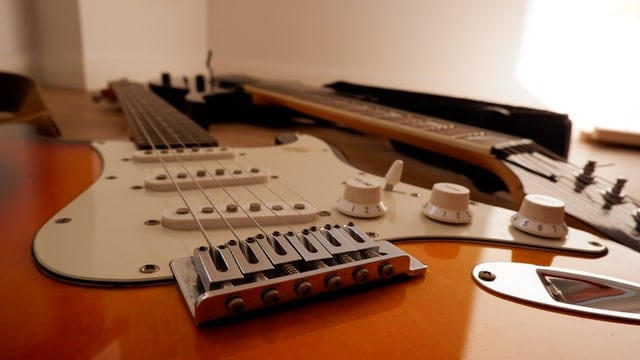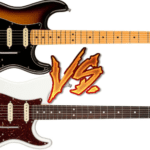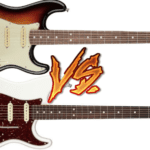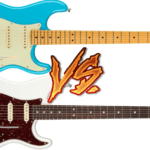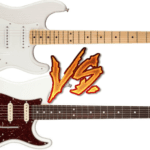Fender has been one of the leading music brands throughout music history and is well-known not only because of its glorious instruments but also for the diverse equipment being them amplifiers and pedal effects among others.
Today we will be breaking up the tone of what could be their most characteristic guitar model: the Fender Stratocaster.
This renowned electric guitar has been used by hundreds of music legends such as Stevie Ray Vaughan, David Gilmore, Eric Clapton, and even Jimi Hendrix.
But what makes this guitar so peculiar? What is that ringing sound which catches our attention?
Well, I bet you have already heard about the strat “quack” and “chime” and that’s what I’d like to talk to you about.
Both “Quack” and “Chime” are terms mainly employed to refer to the distinguishing Stratocaster’s tone. Whilst quack alludes to the guitar sound in the second and fourth pickup selector’s positions, chime has more to do with the specific guitar’s tone.
We are aware that all this information may be overwhelming for inexperienced players but don’t worry, I’m here to help you.
In this article, I will try to explain every existing doubt regarding this thrilling topic, we will define what is understood by each term plus you will be given ways to achieve these tones; in the end, you will become an expert on this issue.
What is Stratocaster “quack”?
The Fender Stratocaster is one of the most famous and recognizable guitars among musicians and, the same way other models, the strat has its own distinctive tone.
As mentioned earlier, this double-cutaway guitar presents a feature that is called “quack”.
Contrary to what you may think, “quack” has nothing to do with the sound that ducks make, at least not literally.
Simply, what quack refers to is the nasal, sharp, high tone that Stratocasters have when placing the pickup selector in the in-between positions.
When talking about in-between positions, we refer to the second and fourth positions of the pickup selector, and they are called “in-between” because they are found by combining the neck plus middle pickups and also the middle plus bridge single coils.
This occurs because both positions are wired in parallel; contrary to what happens in series circuits wiring, the current flows separately through each pickup instead of flowing from one to another.
The resulting sound comes from the modest canceling of frequencies when both pickups are combined (similar to the process humbuckers perform but not completely equal).
In terms of sound, what you can get apart from the increase in high frequencies is a delicate reduction in the midrange, providing a kind of hollow tone in the lower frequencies.
Another relevant feature is that midrange reduction makes the notes pop, which produces a particularly interesting sound.
What is Stratocaster “chime”?
Stratocaster is instantly recognizable not only by its distinctive shape but also by its tone, that is because of how is designed, the combination of three single-coil pickups in different places along the body provides many tonal options depending on the setup.
Of course, this feature is well-known by experienced players but this particular characteristic is known as “chime” by strat enthusiasts.
That term defines perfectly the bright, shiny sound presented in this guitar but some musicians claim that it refers to other things.
Some guitarists state that “chime” has more to do with amp settings, and some others say that it refers to the one or the other in-between position themselves, however, I would say that the word “chime” is used to describe the overall tone of the Stratocaster.
Can any other guitar model “quack” or “chime”?
As mentioned before every guitar possesses its own tone, quack and chime are just colloquial ways to describe the features of the strat tone, the same way players use terms such as “woody” or “sandy” to define other kinds of sounds.
Generally, strats are the way to go if you are looking for that quacky sound but tone tweakers would say that by using the proper setup, similar instruments could possibly achieve sounds alike.
Is there a way of improving the “quack” or “chime” of your strat?
Quack or chime could be obtained in any Stratocaster model, no matter, if they are high-end instruments or an affordable model, the rule of thumb, is three single-coil pickups configuration.
Furthermore, this sound may be improved by playing a vintage model version.
Usually, vintage spec instruments are the gold standard for these tones, nevertheless, your playing style will have a great impact.
In addition, how your amp is set will influence the outcome, a good way to reinforce the quack or chime is to turn up the high frequencies but not so much because otherwise, the sound will be too sharp.
How to achieve a quacky strat sound?
To get a quacky strat the in-between positions are quintessential, using the second and fourth pickup positions is a must.
Moreover, to fully achieve the desired quack is important to play with an aggressive attack, striking the strings usually with a pick.
On some occasions, a little bit of muting may be useful to reinforce the quacky tone.
This sound is pretty noticeable in funky strummings, where every mentioned technique is combined, the violent string hitting plus some fretting hand muting.
How to get a chimey strat sound?
According to some guitar players, the chime is the most salient characteristic of Strats, you get that fantastic sound because of their single coils, and is quite particular because other models do not produce this tone, Telecasters don’t have chime and neither do LesPauls.
Although by using open chord voicings you will make the chime more recognizable, not everything relies on the instrument itself so, to get a chimey strat sound you should focus on your amplifier as well.
This feature has a lot to do with the amp, that’s why it is important to get equipment that provides good cleans and lots of headroom to fully achieved the desired result.
What is more, to take profit from the amp’s settings, I suggest you have your guitar’s tone knobs completely open, in that way, there won’t be cuts in the high end.
Should every “strat” quack and “chime”?
Although the standard Stratocaster comes with a three single-coils configuration, it can also have different pickups such as humbuckers, coil-sized buckers, or even P90s.
Therefore, these unalike versions of the same guitar could be used for very dissimilar genres, that’s why I would say that not every strat should always quack and chime.
A super Stratocaster intended for playing genres such as metal or hard rock is quite unlikely to provide these characteristics, both attributes of its sound might be present in a small form, though.
Needless to say, the tone is subjective so if you feel comfortable using a strat due to its playability but don’t like or you cannot incorporate chime or quack to your playing style, you do not have to do it; try to find the tone you desire and don’t pay attention to those musicians who affirm how a specific guitar must sound.

Hello there, my name is Ramiro and I’ve been playing guitar for almost 20 years. I’m obsessed with everything gear-related and I thought it might be worth sharing it. From guitars, pedals, amps, and synths to studio gear and production tips, I hope you find what I post here useful, and I’ll try my best to keep it entertaining also.

